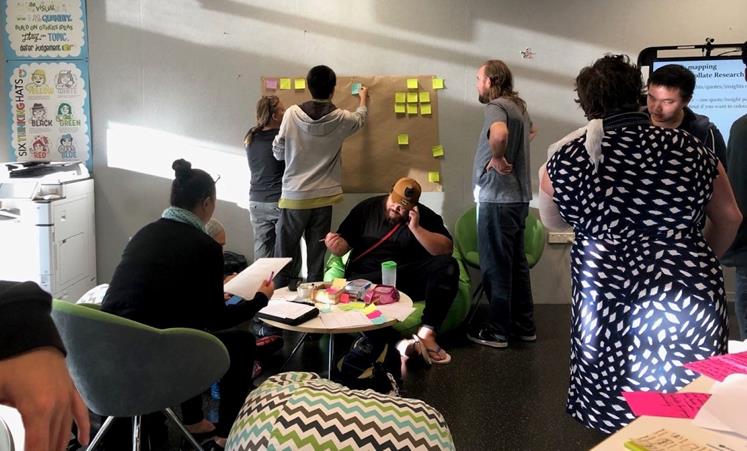Global students trade solutions for voter turnout, real vanilla and a shrinking carbon footprint

The Design Factory NZ team in action taking problem solving to new levels during the global Rat Relay.
The Rat Relay is fast becoming an annual highlight for Design Factory NZ and this international design hack-a-thon proves learning problem-solving skills can be fun and fast-paced.
The 2019 event, organised by Aalto Design Factory in Finland, had nine participating Design Factories – including groups from New York, Seoul, Helsinki, Columbia and Wintec Design Factory NZ in Hamilton, New Zealand.
Hamilton City Council provided Wintec’s Design Factory NZ with a fantastic challenge.
Hamilton’s population has an average age almost six years below the national median. The council are seeking to engage with this youth demographic at a deeper level. Historically, Hamilton has experienced low voter turnout, with only 33 percent of potential residents voting in local body elections – one of the lowest regional turnouts in New Zealand. This year is an election year for the council, so increased engagement for this demographic is likely to make a difference.
This challenge was sent to Cali Design Factory (Colombia) and RTU Design Factory (Latvia), who formed student teams and interviewed local students, politicians and employers to gain a global perspective on the challenge. Within 24 hours, both design factories had developed “How might we?” questions, driven from their research, to reframe the challenge and guide next steps for the council.
These questions included how a Hamilton based non-profit organisation could be formed to simplify and discuss politics, how social media might be utilised and how the Hamilton community could make young people’s issues more visible for politicians to increase their engagement.
“We enjoyed sharing this problem with our global partners,” said Design Factory NZ coach Jeremy Suisted.
“Their feedback was incredibly valuable for Hamilton City Council and our Wintec students working on this project, and there are plans for potential implementation in the short-term future.”
At the same time, two groups from Wintec’s Design Factory NZ worked on challenges shared from Ghent Design Factory (Belgium) and Cali Design Factory. The Ghent Challenge was focused on the unique situation with their study abroad scheme. More than 25 percent of Ghent University students choose to study in a different country during their tertiary years, with the majority choosing to fly to locations within continental Europe.
This is having a significant impact on Ghent University’s carbon footprint, increasing their total carbon contribution by 15 percent. Their challenge to us? How could we help them encourage students to travel by a different method.
The team of first-time-design-thinkers highlighted new factors for Ghent Design Factory to explore, including travel by car and train and encouraging communal travel – creating road-trips out of routine journeys.
RTU Design Factory, based at Riga Technical University in Latvia, had a fascinating challenge from a local natural vanilla supplier. Most of the world’s vanilla consumption is synthetic, as the natural production of vanilla is slower and more expensive to create. How might they increase the demand for natural vanilla?
The Wintec group of 14 students met with 20 people to discuss their experience of high-quality, high-value food products – and see what motivated their purchasing decisions. Drawing on the New Zealand example of manuka honey, participants revealed they enjoyed natural products – but were reluctant to spend money on new products when they were unclear of the benefits.
This research motivated RTU Design Factory to explore how they might encourage the government to create the national market for vanilla, rather than relying on individual operators, and how they could provide taste-and-learn experiences of natural vanilla.
“It’s been fascinating working on such a wide range of problems,” said Jeremy. “We love seeing students come along – with no idea what they’re going to be working on – and then jumping in, trusting the process, and discovering potential solutions along the way.”
How the Rat Relay works:
The Rat Relay is a simple concept. Each Design Factory identifies a local challenge from a local industry partner – before this is shared to two other Design Factories from a different country and culture.
Over two six-hour sessions, each Design Factory runs a local hack-a-thon, with staff and students combining to explore, interview and help solve the received problem. Their findings are then ‘packaged’ and sent back to the original industry partner, for their use in future problem-solving.
Design Factory NZ is looking forward to hosting the next leg of the Rat Relay at the end of 2019, and will be opening their doors to all interested participants at this time.
Find out more about New Zealand's first and only Design Factory at Wintec.
Read more:
Students bring smart bins, hackathons and virtual reality drones to gala
You’re invited to lunch
There’s a real buzz in the air at Design Factory NZ

